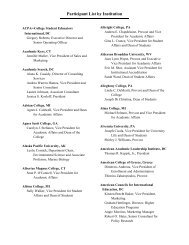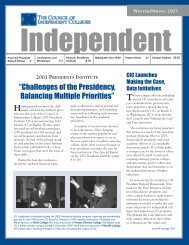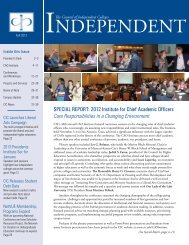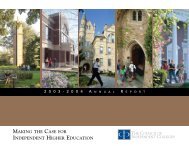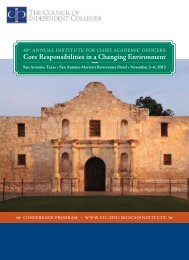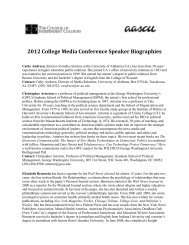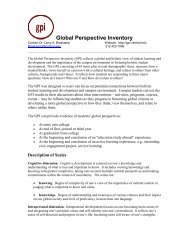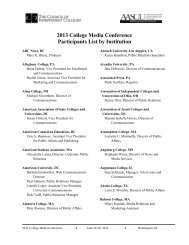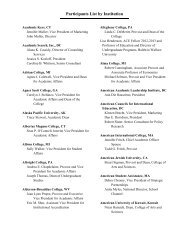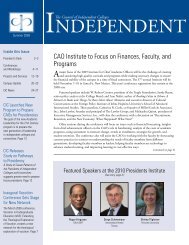Meeting the Challenge: - The Council of Independent Colleges
Meeting the Challenge: - The Council of Independent Colleges
Meeting the Challenge: - The Council of Independent Colleges
You also want an ePaper? Increase the reach of your titles
YUMPU automatically turns print PDFs into web optimized ePapers that Google loves.
Small by Design: Resilience in an Era <strong>of</strong> Mass Higher Education<br />
Small Science is Excellent Science<br />
<strong>The</strong> fascination with bigness influenced American<br />
approaches to science education and research while providing<br />
a model for managing <strong>the</strong> growth <strong>of</strong> undergraduate<br />
enrollments. <strong>The</strong> large university campuses gained attention<br />
and support after World War II when Presidential science<br />
advisor Vannevar Bush persuaded Congress to invest in<br />
serious, high-level scientific research and development as a<br />
permanent post-war commitment. Central to his case was<br />
<strong>the</strong> motto, “Big Science is <strong>the</strong> Best Science.” <strong>The</strong> underlying<br />
premise was that advanced scientific research would flourish<br />
when concentrated in a select group <strong>of</strong> large, established<br />
universities. During <strong>the</strong> next decade, <strong>the</strong> consequences <strong>of</strong> this<br />
priority became evident. Ranking institutions by <strong>the</strong> gross<br />
dollars <strong>of</strong> federal grants received was quickly accepted as a<br />
proxy for prestige. As a result, by 1960 15 large universities<br />
were receiving about 80 percent <strong>of</strong> all federal research grants.<br />
Small liberal arts colleges had a difficult time competing for<br />
<strong>the</strong>se grants in <strong>the</strong> sciences.<br />
It is easy to assume that <strong>the</strong> small liberal arts colleges<br />
were completely left out <strong>of</strong> <strong>the</strong> picture in <strong>the</strong> decades<br />
<strong>of</strong> “Big Science,” simply because <strong>the</strong> majority <strong>of</strong> federal<br />
research grants went to a handful <strong>of</strong> large doctoral-granting<br />
universities. But that assumption is wrong because <strong>the</strong> full<br />
picture was more complex. Many systematic studies now<br />
show that small colleges made significant contributions to<br />
<strong>the</strong> education <strong>of</strong> future scientists all through <strong>the</strong> 20 th century.<br />
Nobel laureate Thomas Cech <strong>of</strong>fers a good account <strong>of</strong> this<br />
contribution in his essay “Sciences at Liberal Arts <strong>Colleges</strong>:<br />
A Better Education” which appeared in Stephen Koblik<br />
and Stephen R. Graubard’s anthology, Distinctively American<br />
(1999).<br />
One reason for <strong>the</strong> popular misconception about<br />
science in <strong>the</strong> small colleges is that many casual observers<br />
presumed that “<strong>the</strong> liberal arts” do not include <strong>the</strong> sciences.<br />
In fact, biology, chemistry, geology, physics, and ma<strong>the</strong>matics<br />
were staples <strong>of</strong> <strong>the</strong> liberal arts curriculum before psychology,<br />
political science, and sociology. As Cech observes, <strong>the</strong><br />
curriculum and culture <strong>of</strong> <strong>the</strong> liberal arts college <strong>of</strong>ten made<br />
it more likely that its students would take science courses<br />
than students at larger institutions. One result is that<br />
graduates <strong>of</strong> liberal arts colleges tend to pursue Ph.D.s in<br />
science and ma<strong>the</strong>matics at a rate substantially greater than<br />
graduates <strong>of</strong> o<strong>the</strong>r institutions.<br />
As one would expect, such academically selective<br />
small colleges as Oberlin, Swarthmore, Williams, Harvey<br />
Mudd, and Pomona are high on <strong>the</strong> lists <strong>of</strong> future Ph.D.<br />
producers. But o<strong>the</strong>r liberal arts institutions with less<br />
visibility and smaller endowments also have very strong<br />
20



